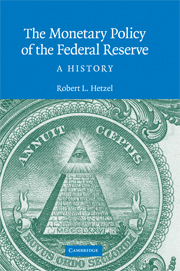Book contents
- Frontmatter
- Contents
- Figures
- Preface
- 1 The Pragmatic Evolution of the Monetary Standard
- 2 Learning and Policy Ambiguity
- 3 From Gold to Fiat Money
- 4 From World War II to the Accord
- 5 Martin and Lean-against-the-Wind
- 6 Inflation Is a Nonmonetary Phenomenon
- 7 The Start of the Great Inflation
- 8 Arthur Burns and Richard Nixon
- 9 Bretton Woods
- 10 Policy in the Ford Administration
- 11 Carter, Burns, and Miller
- 12 The Political Economy of Inflation
- 13 The Volcker Disinflation
- 14 Monetary Policy after the Disinflation
- 15 Greenspan's Move to Price Stability
- 16 International Bailouts and Moral Hazard
- 17 Monetary Policy Becomes Expansionary
- 18 Departing from the Standard Procedures
- 19 Boom and Bust: 1997 to 2001
- 20 Backing Off from Price Stability
- 21 The Volcker–Greenspan Regime
- 22 The Fed: Inflation Fighter or Inflation Creator?
- 23 The Stop–Go Laboratory
- 24 Stop–Go and Interest Rate Inertia
- 25 Monetary Nonneutrality in the Stop–Go Era
- 26 A Century of Monetary Experiments
- Appendix: Data Seen by FOMC for the Stop–Go Period Shown in Figures 24.1, 24.2, and 24.3
- Notes
- Bibliography
- Index
- Titles in the series
15 - Greenspan's Move to Price Stability
Published online by Cambridge University Press: 26 May 2010
- Frontmatter
- Contents
- Figures
- Preface
- 1 The Pragmatic Evolution of the Monetary Standard
- 2 Learning and Policy Ambiguity
- 3 From Gold to Fiat Money
- 4 From World War II to the Accord
- 5 Martin and Lean-against-the-Wind
- 6 Inflation Is a Nonmonetary Phenomenon
- 7 The Start of the Great Inflation
- 8 Arthur Burns and Richard Nixon
- 9 Bretton Woods
- 10 Policy in the Ford Administration
- 11 Carter, Burns, and Miller
- 12 The Political Economy of Inflation
- 13 The Volcker Disinflation
- 14 Monetary Policy after the Disinflation
- 15 Greenspan's Move to Price Stability
- 16 International Bailouts and Moral Hazard
- 17 Monetary Policy Becomes Expansionary
- 18 Departing from the Standard Procedures
- 19 Boom and Bust: 1997 to 2001
- 20 Backing Off from Price Stability
- 21 The Volcker–Greenspan Regime
- 22 The Fed: Inflation Fighter or Inflation Creator?
- 23 The Stop–Go Laboratory
- 24 Stop–Go and Interest Rate Inertia
- 25 Monetary Nonneutrality in the Stop–Go Era
- 26 A Century of Monetary Experiments
- Appendix: Data Seen by FOMC for the Stop–Go Period Shown in Figures 24.1, 24.2, and 24.3
- Notes
- Bibliography
- Index
- Titles in the series
Summary
Volcker and Greenspan shared an intense dislike of inflation and a concern for inflationary expectations (Chapters 10 and 13). Their common desire to reestablish the nominal expectational stability lost with stop–go imposed a “rule-like” character to the FOMC's standard lean-against-the-wind procedures. The essence of the V–G standard was a rule that both created a nominal anchor through the expectation of low, stable inflation and moved the funds rate in a way that allowed the price system to work.
Core PCE inflation fell from 4.5% in 1990 to 2% in January 2006 when Greenspan left the Fed. Greenspan never took any credit for the decline in inflation during his tenure as FOMC chairman. Indeed, he never offered any general vision of how central banks control inflation. Greenspan's (May 2004) characterization of the Fed was that of crisis manager. When Greenspan left, the Fed had not yet articulated the nature of the monetary standard created over the last two decades of the twentieth century. The characterization offered here highlights the similarity of the Greenspan and Volcker years that arose from the emphasis placed on expected inflation measured by bond market behavior.
The Absence of an Articulated Greenspan Standard
The Greenspan FOMC never discussed strategy. The role of the FOMC was to accept or reject Greenspan's funds rate recommendations. Public characterization of monetary policy was also the chairman's prerogative – a characterization that reflected his nonmonetary view of inflation and inflationary expectations.
- Type
- Chapter
- Information
- The Monetary Policy of the Federal ReserveA History, pp. 196 - 205Publisher: Cambridge University PressPrint publication year: 2008

